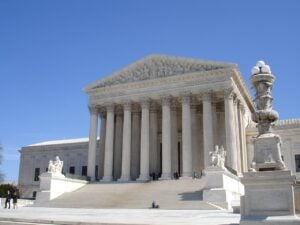The Defenestration Of Affirmative Action By SCOTUS Was Swift. What’s Next For The Legal Profession?
Opponents of race-conscious admission policies have found their long-lost political bedfellows in the judicially active conservative majority of SCOTUS.
 “Did you think we’d be fine? / Still got scars on my back from your knives / So don’t think it’s in the past / These kinds of wounds, they last and they last / Now, did you think it all through? / All these things will catch up to you / And time can heal, but this won’t / So if you’re coming my way, just don’t.” — Taylor Swift
“Did you think we’d be fine? / Still got scars on my back from your knives / So don’t think it’s in the past / These kinds of wounds, they last and they last / Now, did you think it all through? / All these things will catch up to you / And time can heal, but this won’t / So if you’re coming my way, just don’t.” — Taylor Swift
Last month, in the words of Justice Sonia Sotomayor, SCOTUS rolled “back decades of precedent and momentous progress” and “cemented a superficial rule of colorblindness as a constitutional principle in an endemically segregated society.”
SCOTUSblog Columnist Amy Howe succinctly recounts this latest historic ruling in the context of past decisions. As Howe highlights:

Diving Into Generative AI: A Practical Guide For Law Firms Starting From Scratch
Thursday’s ruling was the latest in a series of challenges to the role of race in university admissions. In both the North Carolina and Harvard cases, the plaintiffs had asked the justices to overrule Grutter. In her opinion for the majority in that case, Justice Sandra Day O’Connor reaffirmed that “student body diversity is a compelling state interest that can justify the use of race in university admissions,” but she warned that race-conscious admissions policies should not last forever. In 25 years, she suggested, “the use of racial preferences will no longer be necessary to further the interest” in diversity. …
In a 40-page opinion that addressed both the Harvard and UNC cases, [Chief Justice] Roberts began with a review of the Supreme Court’s past decisions interpreting the equal protection clause. Those decisions, he concluded, reflect the clause’s “core purpose”: “doing away with all governmentally imposed discrimination based on race.” He emphasized that the Supreme Court had only allowed universities to use race-based admissions programs “within the confines of narrow restrictions.” But the Harvard and UNC programs, “however well intentioned and implemented in good faith,” Roberts explained, do not comply with those restrictions.
Opponents of race-conscious admission policies have found their long-lost political bedfellows in the judicially active conservative majority of SCOTUS. In the words of Roosevelt Institute Program Manager Shahrzad Shams, “affirmative action has become the latest victim of the Supreme Court’s agenda to roll back major civil rights gains.”
Needless to say, bad facts and hard cases make bad law. Harvard certainly didn’t do itself any favors by allegedly ranking Asian American applicants lower than others on traits like “positive personality,” likability, courage, kindness, and being “widely respected.” Or by discovering though a 2013 internal investigation, but not publicly acknowledging, its bias against Asian American applicants in its admission policies, as highlighted by The New York Times.
In fact, Justice Clarence Thomas prefaced his decision to speak up in support of the ruling, saying “race-based discrimination against Asian American students compels me.” I won’t dig into the irony of his statement or opine on other substantive issues behind this historic ruling today, but longtime readers may be familiar with my past affirmative action coverage from 2015-2019 in the articles below:
Sponsored

Law Firms Now Have A Choice In Their Document Comparison Software

From AI To KPI: The Law Department Tech Trends Of 2024

Diving Into Generative AI: A Practical Guide For Law Firms Starting From Scratch

Why Do AI And Legal Professionals Make The Perfect Partnership?

- ‘Affirmative Action’ In Law: The Four-Letter Phrase (January 2, 2015)
- Opponents Of Affirmative Action Will Get Another Bite At The Apple Next SCOTUS Term (July 6, 2015)
- Affirmative Action Is Here To Stay (For Now); How Will This Benefit The Legal Profession? (July 15, 2016)
- Asian Americans Are Being Used As A Wedge To Advance The Anti-Affirmative Action Agenda (August 4, 2017)
- As Asian Americans Become More Pivotal In The Affirmative Action Debate, Both Sides Weigh In (August 11, 2017)
- First Edward Blum Came For The Voting Rights Act, Now He Aims To Gut Affirmative Action With The Help Of Asian Americans (October 12, 2018)
- Can We Now Address Legacy Admissions? Or Will We Keep Focusing On Affirmative Action In A Silo? (March 15, 2019)
For more recent coverage on this divisive topic, please visit my Above the Law colleague Chris Williams’s articles:
- The Affirmative Action Cases Went About As Well As You’d Expect Them To. What Now? (June 29, 2023)
- First They Came For Affirmative Action. Then They Came For Legacy Admissions. Good Riddance. (July 5, 2023)
- The Slippery Slope Of Ending Affirmative Action Has Moved On To Its Next Target: Women And ‘Proxies For Diversity’ (July 6, 2023)
- Law Schools Are Still Set On Diversity Even After The Supreme Court’s Affirmative Action Decision (July 19, 2023)
- Could Law Schools Get Biblical On Affirmative Action? (July 20, 2023)
It’s no secret, the legal profession has been struggling with diversity for quite some time. After all, people of color in the legal profession have increased by less than 1% since 2000.
As Reuters Legal Affairs Reporter Karen Sloan observes:
Sponsored

Gain An Instant Understanding Of New Complaints With LexisNexis Snapshot

Why Do AI And Legal Professionals Make The Perfect Partnership?

The stakes are high for the legal profession, which remains significantly less diverse than the U.S. population. ABA data shows that 19% of the country’s lawyers are people of color, compared with 40% of the overall population. By contrast, 36% of physicians are minorities, according to the Association of American Medical Colleges, and 30% of dentists are minorities, according to the American Dental Association.
And Bloomberg Law Reporter Tatyana Monnay notes:
Some law firm leaders said the court’s decision won’t affect their diversity, equity, and inclusion priorities. Other observers worry that a groundswell of diversity initiatives in the wake of the 2020 police-killing of George Floyd, and the reckoning that followed, won’t last. The court’s decision “is now going to put on display how committed you actually are to diversity,” said Lauren Jackson, assistant dean of career services at Howard University’s law school.
Meanwhile DEI offices and programs in higher education are under assault in Texas, Florida, and 30 other states.
So where does the legal profession go from here? Earlier this month, Lateral Link’s Gloria Sandrino, Christina Ahn, and Amy Langan provided a roadmap for how someone can redouble their efforts when it comes to fostering diversity in the legal profession. In their article, Promoting Diversity In Law: A Strategic Guide For Navigating The Post-Affirmative Action Legal Landscape, they describe and recommend:
- Deepening partnerships with law schools and alumni associations
- The power of personal interaction and mentorship programs
- Tailored mentorship: fostering success for diverse students
- Collaborative partnerships: supporting racially diverse attorneys
- Curating initiatives for diversity in law firm partnerships
- The importance of intentionality in diversity efforts
The Diversity Movement (TDM) CEO Donald Thompson echoes this sentiment in his WRAL op-ed: “The fear is real, but the response can’t be to cower. Instead, we need to double-down on DEI programming, not just because it’s the correct thing to do morally or ethically, but because it is what customers, employees, shareholders and stakeholders want.”
If you are looking for a good place to recommit to your DEI voyage, I highly recommend you explore the TDM Library free trial. This is a great resource for ideas and strategies to improve diversity in your law firm’s talent acquisition, recruiting, and workplace processes (Disclosure: I’m a board advisor for TDM).
Lastly, please let us know if your law firm or law school has instituted specific initiatives or targeted programs to increase diversity among its ranks in response to this historic SCOTUS decision. We’d love to learn more from our readers about how the legal industry is reacting to this latest ruling.
Renwei Chung is the DEI Columnist at Above the Law. He currently serves as a Board Advisor for The Diversity Movement (TDM), and hosts the Charge the Wave podcast — focused on entrepreneurs, executives, and icons who are assiduously building companies, cultures, and communities.







